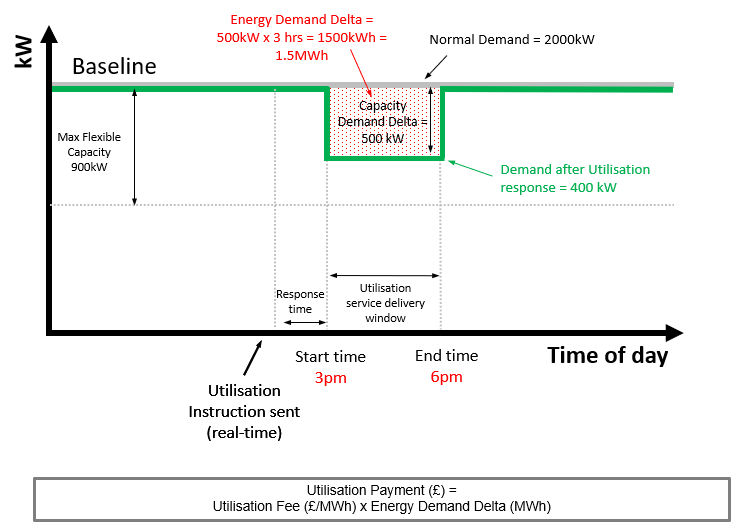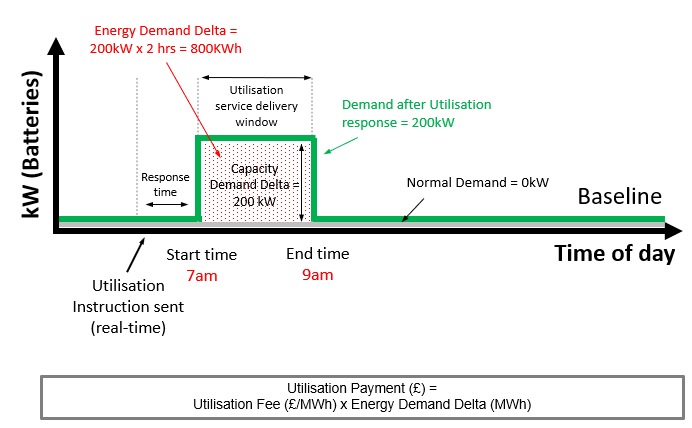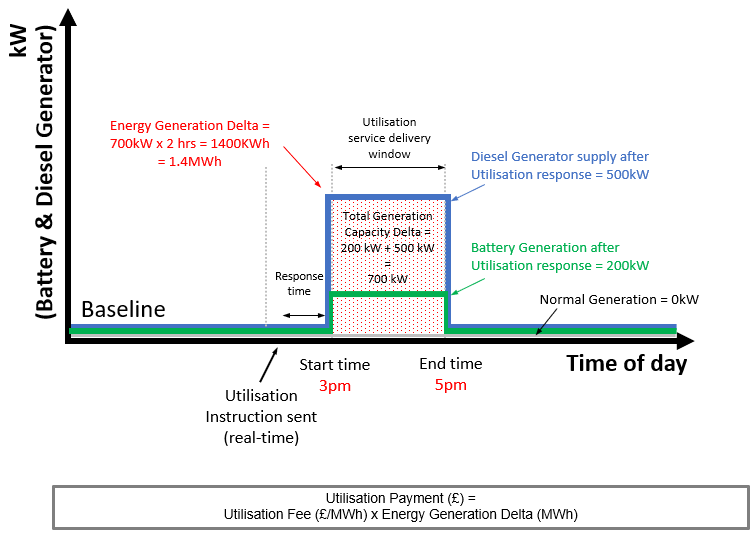University case study
Introduction
A university who has energy storage assets and a diesel generator on their site is looking to provide flexibility services to Electricity North West through an Operational Utilisation contract by increasing/decreasing electricity supply or increasing/decreasing electricity demand during peak times or unplanned outages/faults.
About flexibility services
When the demand for electricity is greater than the amount that Electricity North West can provide, we procure flexibility services to alleviate constraints on our network during peak times. These services are provided by companies or individual customers known as flexibility providers, who own assets in our region such as generators, battery storage and electric vehicle (EV) charge points that can generate more or use less electricity during a pre-agreed service delivery window, and can provide a minimum of 10kW either individually or via an aggregator. This allows us to balance supply and demand, ensuring a safe and reliable supply of energy for our customers and in return for providing extra capacity, flexibility providers receive payment from Electricity North West.
Delivering a peak reduction service via demand reduction
The Operational Utilisation service is a pre-scheduled product that is procured to manage daily demand peaks or post-outage/fault response on the network.
There are a number of ways the university can adjust their energy demand and supply to deliver the Operational Utilisation service during the required window. These could include utilising energy storage assets (such as batteries) and a temporary diesel generator already installed at the campus.
Battery energy storage enables demand flexibility by storing surplus energy during periods of low demand (for example late at night or early morning) and releasing it during peak hours (for example between 4-8pm on a winter’s day), so that a site does not have to draw from the grid. By participating in this service, sites can store energy from solar or direct from the grid at off-peak times which is then used if requested during pre-arranged hours of participation.
Diesel generators can be utilised to provide temporary dispatchable power generation to the grid during network constraints or help power flowing during a fault/outage or be utilised by the university to limit its power import from the network during peak hours.
Pre-tender
Our tenders are published on the ElectronConnect platform twice a year in spring and autumn in line with our Network Development Plan (NDP) and Distribution Future Electricity Scenarios (DFES) publications to reflect our latest network requirements. To be notified of our upcoming tenders, the farmer signs up to our flexibility mailing list.
Prior to the launch of the tender, the university:
- Registers the company on ElectronConnect to pre-qualify to participate. The information submitted such as credit checks and insurance details are assessed by Electricity North West and once approved, the company's commercial qualification remains valid for future tender rounds
- Electricity North West utilises the framework style Standard Flexibility Services Agreement developed by the Energy Networks Association Open Networks Project.
- Registers and pre-qualifies the assets they wish to put forward in the competition.
Tender process

Pre-qualification
Once the Invitation to Tender (ITT) has been published, the university reviews the network’s flexibility services requirements using the interactive map on the platform and upon establishing that the assets are located within a requirement zone seeking an Operational Utilisation service, they calculate how much of the required demand response it can offer, when, and at what price. Prior to submitting a bid, the university uses the on our website to check that the prices they are prepared to offer for availability and utilisation don't exceed the ceiling price that we are offering for the service as part of this tender round. The cost calculator can also be found within the ITT appendices. At this point, the university has decided they would like to participate in the tender.
Their next step is to complete technical qualification on their chosen platform by confirming the assets they wish to put forward in the competition. Electricity North West then validates where the battery storage assets are connected to our network and that they’re eligible to participate, assess the technical details of the participating assets and their capability for delivery. If the university does not have 10kW of flexible capacity to offer it can still take part via a third party (an aggregator) – this is explained in more detail under a separate case study. The university is notified via ElectronConnect that their assets meet the requirements of this tender, allowing them to move to the bidding stage of the process.
Submitting a bid
For the final stage of the procurement process, the university submits a bid to the tender on ElectronConnect. This is carried out by linking the pre-registered assets to the utilisation payments, as well as the periods where the university can deliver utilisation of the response. Once the bidding window has closed, Electricity North West assesses the tender responses before accepting or rejecting bids based on the proposed payment and the asset’s ability to meet the specification. If the University's bids are successful, they will then enter into a flexibility services agreement with Electricity North West to deliver the service within the required service windows.
.
Helpful tips to consider pior to submitting a bid:
- Prices should be made up of a Utilisation payment. Utilisation is the price paid to the provider for the level of response they have actually provided on request. Note: Electricity North West will not always utilise as much energy as they have requested for in the service window, there is a level of over procurement built in to ensure that there will be a sufficient response available if required.
- When calculating the tender bid prices the provider should consider the cost of lost revenues, fuel costs, environmental or permit fees, initial set up costs, maintenance, other revenue streams available, energy savings benefits etc.
- When thinking about the Utilisation periods the provider should consider the practicalities of these Utilisation periods, the processes required to ensure that the service can be delivered, seasonal considerations e.g. increased demand during sport events, major television events, Christmas period, weather related issues (e.g. extreme cold weather increasing the heating demand) and maintenance periods.
Flexible Service products
Electricity North West procure three common products (services) which align with the Open Networks service definitions:
- Peak Reduction
- Operational Utilisation
- Operational Utilisation and Variable Availability
The Operational Utilisation product is designed to provide a post abnormal event ability to quickly reduce network demand and restore network supplies following an unplanned outage/fault. Typical examples of usage would be network faults, extremely unlikely demand peaks caused by unplanned events (weather, sporting events, major televised events), or under delivery from another FSP.
The service window(s) will be agreed in advance within its contract with Electricity North West. Electricity North West will also provide an estimation of the level of response that will actually be required.
Dispatch
The University is expected to be ready to respond to Utilisation calls within the agreed response time (15 minutes maximum). The assets will be dispatched for the required level of service that is required based upon actual network measurement data. The University can choose to receive dispatch instruction via Application Programming Interface (API), email, or Electricity North West owned Remote Terminal Units (RTU).
Baselining
A baseline is a reference used to measure the amount of flexible capacity delivered to the network by flexibility providers. There are different kinds of baselining methodologies used depending on the type of asset and service being provided. These include historical baselines (using past meter readings to estimate the baseline using standard algorithms) and nominated baselines (using other forecasting techniques such as weather-based models to estimate the future baseline). The baselining methodology will be agreed between Electricity North West and the University post contract award and at least 6 months prior to the first utilisation period. More information on the different types of baselining methodologies can be found on our FAQs page.
Payment
Utilisation payments will be made to the University for responding to Electricity North West’s dispatch request during the service window(s). Payment is awarded on successful delivery of the services and will depend on the level of response they have actually provided on request. It is measured in £/MWh.
It is noted that the Utilisation Fees payable to the University under this product are subject to Electricity North West’s actual utilisation of the University’s flexibility services closer to real-time. The University will not be paid for being available (standby) to respond to Electricity North West’s dispatch signals and will not receive any payment if there won’t be any need for utilisation of their assets in real time.
Invoicing
Subject to the delivery of Flexible Services, the University will invoice Electricity North West and will receive payment by bulk electronic clearing (BACS) by the end of the following month (after such invoice is received).
It is noted that:
- Over-delivery is not paid and cannot be used to compensate for under delivery during another dispatch request.
- The University is not entitled to any payment during the response time.
More details on invoicing and payment can be found within the Terms & Conditions of each Invitation to Tender.
Worked example :
The University has a battery with 500kW of power capacity and a diesel generator of 400kW capacity and has signed an Operational Utilisation service (demand turn-up/down & generation turn-up/down) contract with Electricity North West. The University has a MIC of 2000kW.
The University can:
- Reduce its demand by up to 900kW in total; 500kW by utilising the batteries (assuming they are fully charged) and 400kW by utilising the diesel generator (assuming it is fully re-fuelled) to meets its own electricity requirements during peak hours.
- Increase its demand by up to 500kW by charging the batteries during periods of low network demand.
- Release (generate) power to the grid up to 900kW in total; 500kW by utilising the battery and 400kW with the generator, to provide post-fault response or during daily demand peaks.
The batteries can run for up to 3 hours and need 1 hour to fully re-charge (i.e. restoration time). The generator can run for up to 4 hours and needs 1 hour for re-fuelling (i.e. restoration time).
In this example, for demand reduction/ generation increase the service window period is November-March every Mon-Fri between 3pm-8am and for demand increase it is 24/7 all year round. The University said they can respond to utilisation requests within 10 minutes.
Utilisation dispatch (demand reduction): It is assumed there is a network constraint on a weekday in December. Electricity North West will send a utilisation dispatch request in real-time to the University to reduce its demand by 500kW between 3pm-6pm. The University must respond to the Utilisation call within 10 minutes from receiving Electricity North West’s dispatch signal. They can respond by covering it energy demand by either using the stored energy in the batteries or by utilising the diesel generator or both. If the University successfully manages to reduce its demand within 10 minutes, they will receive payment for decreasing their energy consumption by 500kW x 3 hours = 1500kWh (or 1.5MWh) in their demand profile between 3pm-6pm compared to their expected energy demands (based on its historical demand profiles).
Below is an example of the University responding to a utilisation instruction for demand reduction using its batteries (site metering)

Utilisation dispatch (demand increase): It is assumed there is generation surplus on the network on a sunny Sunday in July. Electricity North West will send a utilisation dispatch request in real-time to the University to increase its demand by 200kW between 7am-9am. The University must respond to the Utilisation call within 10 minutes from receiving Electricity North West’s dispatch signal. They can respond by charging the batteries. If the University successfully manages to increase its demand within 10 minutes, they will receive payment for increasing their energy consumption by 200kW x 2 hours = 800kWh in their demand profile between 7am-9am.
Below is an example of the University responding to a utilisation instruction for demand increase using its batteries (asset metering)

Utilisation dispatch (generation increase): It is assumed there is a demand peak in the network on a weekday in December. Electricity North West will send a utilisation dispatch request in real-time to the University to increase its generation by 700kW between 3pm-5pm. The University must respond to the Utilisation call within 10 minutes from receiving Electricity North West’s dispatch signal. They can respond by releasing the stored energy in the batteries and utilising the diesel generator to generate electricity to the grid. If the University successfully manages to increase its generation within 10 minutes, they will receive payment for the generating 700kW x 2 hours = 1400kWh (or 1.4MWh) of energy between 3pm-5pm.
Below is an example of the University responding to a utilisation instruction for demand increase using its batteries and the generator (asset metering)

Useful links
Register for updates
Sign up to our flexibility mailing list to get notified when we publish a new requirement and receive invites to our events.
Get in touch
If you have any questions relating to flexible services or would like to book a meeting with a member of our team, please get in touch using this online form.
One-to-one discussions
We host one-to-one discussions to guide stakeholders through the process of providing flexibility services to the network.